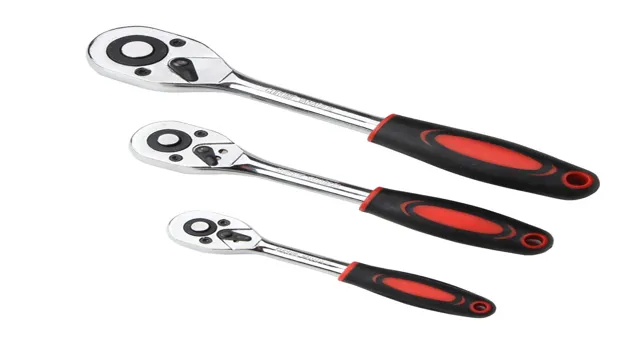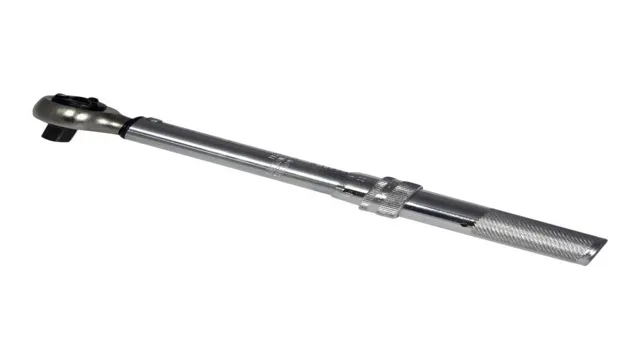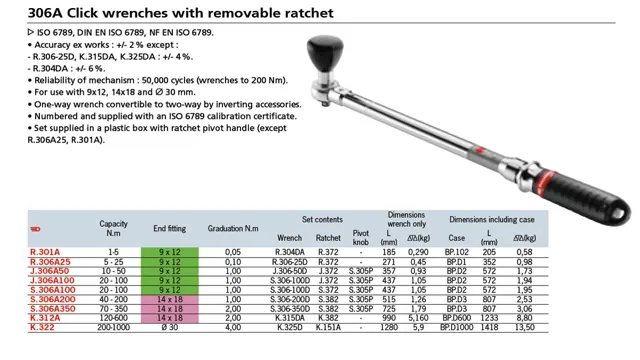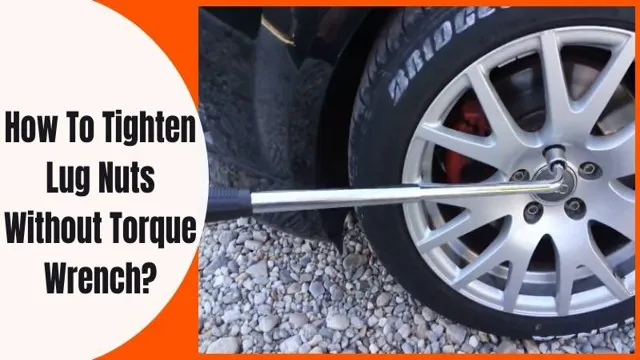Can I Use Torque Wrench as Ratchet? The Ultimate Guide for DIYers and Mechanics

When it comes to DIY projects and basic repairs around the house, having the right tools can make all the difference. One tool that may come to mind is the trusty ratchet, which is often used to tighten or loosen bolts and nuts. But, have you ever considered using a torque wrench as a ratchet? While these two tools may seem very different at first glance, they do share some similarities that make the torque wrench a versatile addition to your toolbox.
A torque wrench is a tool used to apply a specific amount of force, or torque, to a bolt or nut. On the other hand, a ratchet is a tool used for tightening or loosening bolts and nuts by turning them back and forth. While a torque wrench is meant for specific torque values and a ratchet is not, there are scenarios where they can both be used interchangeably.
If you’re in a pinch and don’t have a ratchet on hand, a torque wrench can still get the job done. The square drive on a torque wrench can fit most standard sockets, allowing you to use it as a ratchet. Additionally, a torque wrench has a reversible ratchet mechanism built-in, making it easy to switch from tightening to loosening bolts and nuts.
Overall, using a torque wrench as a ratchet can provide a backup plan when your go-to tool is not available. However, it’s important to note that torque wrenches are meant for specific torque values and should not be used as a replacement for a ratchet on a regular basis. By understanding the similarities between these tools, you can ensure that your toolbox is well-equipped for any project that comes your way.
What is a Torque Wrench?
If you have ever worked on a car or any machinery, you may have heard about torque wrenches. A torque wrench is a tool designed to tighten bolts and nuts to a specific torque or tightness level. Usually, this tool is used in engineering and automotive industries where precise torque is required.
In contrast, ratchets are a type of hand tool that allows forward and backward motion of fasteners. So, the question arises, can you use a torque wrench as a ratchet? Technically, yes, you can use a torque wrench as a ratchet, but it is not recommended. It is because the torque wrench has a calibrated mechanism that requires a specific amount of force to prevent over-tightening or under-tightening.
On the other hand, a ratchet does not have this precision mechanism. Therefore, using a torque wrench as a ratchet may damage the tool and invalidate its calibration. So, it is better to use each tool for its designated purpose to ensure accurate and safe work.
Definition and Function
A torque wrench is a specialized tool designed to precisely tighten nuts and bolts to a specific level of tension or torque. Torque wrenches are commonly used in automotive repairs, construction, and other industries where precise tightening is critical for safety and performance. The primary function of a torque wrench is to apply a specific level of force to a fastener, ensuring that it is tightened to the correct level of torque without over or under-tightening.
This is important because over-tightened fasteners can damage equipment or cause bolts to snap, while under-tightened fasteners can create loose joints or poor seals. Using a torque wrench helps to ensure the safety and reliability of machinery and equipment, making it an essential tool for professionals in many industries.

Types of Torque Wrenches
A torque wrench is a tool that helps you apply a specific amount of force on a nut or bolt. It is essential to use a torque wrench in many fields, including automotive, mechanical, industrial, and construction. A torque wrench is calibrated to apply a specific amount of force or torque, typically in foot-pounds or Newton-meters.
Using a torque wrench ensures that the bolt or nut is tightened to the specified torque and not over or under-tightened. There are several types of torque wrenches available in the market. The most common type is the click-type torque wrench, which emits an audible click sound when the pre-set torque is reached.
Another type is the beam-type torque wrench, which has a pointer that indicates the amount of torque being applied. The third type is the digital torque wrench, which displays the torque value on a screen. Each type of torque wrench has its advantages and disadvantages.
The click-type torque wrench is easy to use and provides an audible indication when the torque is reached. However, it may not be the most accurate type of wrench. The beam-type torque wrench is more accurate than the click-type but can be difficult to read for inexperienced users.
The digital torque wrench is the most accurate and easy to use but is also the most expensive. In conclusion, choosing the right torque wrench depends on your specific requirements. If you need a torque wrench for occasional use, a click-type wrench may suffice.
However, if you need the most accurate tool for critical applications, a digital torque wrench is the best choice. Whichever type you choose, make sure to use the right torque setting for the bolt or nut you are working on to ensure proper and safe tightening.
What is a Ratchet?
The short answer is no, you cannot use a torque wrench as a ratchet. While it may seem tempting to repurpose tools for different uses, torque wrenches and ratchets are designed for different tasks. A torque wrench is used to apply a specific amount of torque to a bolt or nut, ensuring it is tightened to the manufacturer’s specifications.
A ratchet, on the other hand, is used to turn bolts or nuts in tight spaces where a regular wrench won’t fit. A ratchet has a mechanism that allows you to turn the bolt or nut without removing the wrench from it each time. In summary, torque wrenches are not suitable for use as ratchets because they lack the necessary mechanism.
Trying to use a torque wrench as a ratchet could lead to damage to both the tool and the bolt or nut you are working on. Therefore, it’s better to invest in both tools to ensure you have what you need for the job at hand.
Definition and Function
If you’ve ever used a wrench, you may have noticed a ratcheting sound as you turn it. That’s because a ratchet is a mechanical device that allows a rotary or reciprocating motion to be continuous in one direction while preventing motion in the opposite direction. Essentially, a ratchet is like a one-way gate for motion.
It is most commonly found in tools like wrenches and socket sets, but it can also be used in machinery to prevent backwards motion or to control the speed of a rotation. The main function of a ratchet is to make it easier to tighten or loosen nuts and bolts in tight spaces. Without a ratchet, you would need to lift the wrench off the bolt after each turn, which can be challenging in cramped areas.
However, with a ratchet, you can simply turn the handle in one direction and the ratchet mechanism will ensure that the wrench stays in contact with the bolt. Overall, a ratchet is a simple yet essential tool that makes mechanical work much easier.
Types of Ratchets
A ratchet is a hand-operated mechanical device that enables rotational or linear motion in one direction only. It’s primarily designed for use in tightening and loosening bolts, nuts, and fittings. A standard ratchet consists of a handle, a round metal head, and a socket that fits onto the bolt or nut.
The head contains a pawl that clicks over the teeth of the gear in one direction, allowing the ratchet to rotate, but prevents it from moving backward when force is applied back through the handle. Ratchets come in different types, including fixed and adjustable, with various handle lengths, head sizes, and socket types. Fixed ratchets have a head that rotates around the handle, while adjustable ratchets have a pivot point that can move the head to different angles.
Both types are available in different ratchet sizes to accommodate different socket sizes. Ratchets make mechanical tasks more manageable and efficient, and having the right type of ratchet for the job can save you time and reduce the risk of damaging bolts and nuts.
Can a Torque Wrench be Used as a Ratchet?
Many people wonder whether they can use a torque wrench as a ratchet, and the answer is not straightforward. While a ratchet is primarily designed to tighten and loosen bolts, a torque wrench has a more specific purpose, which is to apply precise torque to a fastener to achieve a specific level of tightness. Therefore, using a torque wrench as a ratchet is not recommended, as it can lead to inaccurate torque measurements, potentially causing damage to the fastener or the object being fastened.
In addition, using a torque wrench in such a manner can put unnecessary wear and tear on the tool, leading to its failure. Therefore, it’s best to use the right tool for the job at hand and avoid using a torque wrench as a ratchet. Remember: while these two tools may appear similar, they are designed with different functions in mind, and using one in place of the other can cause serious problems.
Pros and Cons
Torque wrench Using a torque wrench as a ratchet might seem like a smart thing to do, but it has both pros and cons. On the positive side, it is a versatile tool that can perform both tightening and loosening tasks, which is very convenient. Moreover, if you can’t find your ratchet, you can use the torque wrench as a substitute.
It could also save you money since you don’t have to buy both a torque wrench and a ratchet. However, there are some downsides to using a torque wrench as a ratchet. First, torque wrenches are designed to measure torque to a specific level, and using them for other tasks could increase wear and damage.
Second, torque wrenches may not be as efficient as ratchets when it comes to removing bolts in tight spaces. This is because a torque wrench’s length might be an obstruction. Finally, using a torque wrench as a ratchet can lead to inaccurate torque readings, which could cause safety risks.
Therefore, it is recommended to use the right tool for the right task. A torque wrench should be used exclusively for measuring and tightening bolts according to the manufacturer’s specifications.
Safety Considerations
If you’re working on a project that requires tightening bolts or nuts, you may wonder if you can use a torque wrench as a ratchet. While it may seem like a good idea to use a torque wrench for multiple purposes, it’s important to note that torque wrenches and ratchets serve different functions. A torque wrench is designed to precisely tighten bolts or nuts to a certain torque specification, while a ratchet is used to quickly tighten or loosen bolts or nuts.
Attempting to use a torque wrench as a ratchet could lead to damage of the torque wrench, improper tightening of bolts, and most importantly, safety hazards. When using a torque wrench, it’s crucial to follow the manufacturer’s instructions, including proper calibration, using the correct sockets and adapters, and avoiding exceeding the maximum torque limit. A torque wrench is a precision tool that should be used with care and caution.
In summary, a torque wrench should not be used as a substitute for a ratchet. Using a torque wrench for a different purpose than it’s intended could result in damage to the tool, improper tightening of bolts, and safety hazards. Always follow the manufacturer’s instructions and use the appropriate tool for the job to ensure safety and accuracy.
Conclusion
In conclusion, while you technically can use a torque wrench as a ratchet, it’s like using a Ferrari to run errands – it’s overkill and not the intended use. Plus, you might end up damaging the torque wrench or compromising the accuracy of your torque measurements. Stick to using the right tool for the job and save yourself from potential headaches down the road.
“
FAQs
What is a torque wrench, and how does it work?
A torque wrench is a tool used to tighten bolts, nuts, and other fasteners to a specific torque value. It features a calibrated scale and handle that allows the user to set the desired level of torque. When the torque limit is reached, the wrench will click or release tension to signal the user to stop tightening. A torque wrench should only be used for tightening, not loosening.
What is a ratchet, and how does it work?
A ratchet is a tool used to tighten and loosen bolts and nuts. It has a gear mechanism that allows the user to rotate the handle in one direction while the socket remains stationary. When the handle is turned in the opposite direction, the gear mechanism engages, allowing the socket to turn in the same direction. This enables the user to turn the fastener repeatedly without removing the tool from the bolt or nut.
Can I use a torque wrench as a ratchet?
While a torque wrench and a ratchet may look similar, they serve different purposes and should not be used interchangeably. A torque wrench is designed to apply and measure specific levels of torque when tightening fasteners, while a ratchet is designed to turn fasteners repeatedly in either direction. Using a torque wrench as a ratchet may damage the tool and affect its accuracy in measuring torque.
What is the difference between a click-type torque wrench and a beam-type torque wrench?
Click-type torque wrenches are equipped with a clutch mechanism that makes an audible “click” sound when the desired torque level is reached. Beam-type torque wrenches, on the other hand, use a calibrated steel beam that flexes when torque is applied. The user must visually read the scale on the beam to determine when the desired torque level has been reached.
How often should I calibrate my torque wrench?
Torque wrenches should be calibrated regularly to ensure accuracy. The frequency of calibration depends on the type of tool, how often it is used, and the level of precision required. Generally, torque wrenches should be calibrated at least once a year or after any impact that may have affected its accuracy. Some industries may require more frequent calibration to meet specific standards.
Can I use a torque wrench to loosen bolts?
Torque wrenches should not be used to loosen bolts. They are designed to tighten bolts to a specific torque value. Using a torque wrench to loosen bolts may damage the tool and affect its accuracy in measuring torque.
How do I choose the right torque wrench for my needs?
The right torque wrench depends on the application, the required torque range, and the level of precision needed. Click-type torque wrenches are ideal for most general automotive and mechanical applications, while digital torque wrenches may be better suited for high-precision applications. It’s important to choose a torque wrench with a torque range that includes the torque specifications for the job at hand. The tool should also be comfortable to use and well-made to ensure accuracy and longevity.



